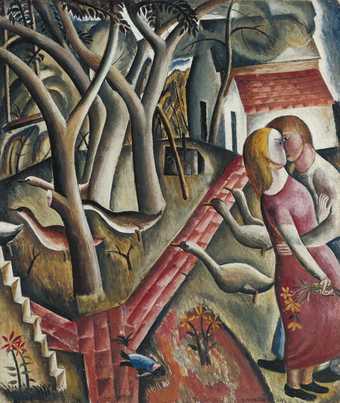
David Jones
The Garden Enclosed (1924)
Tate
The Garden Enclosed 1924 is a little painting with a power that exceeds both its size and its apparent simplicity. A man and a woman embrace in a garden; or rather, he embraces her - for there is some ambiguity as to her active part in this. In one hand she still holds the flowers she has been picking, while with the other she either pushes him away, or halts his advance, or merely touches him above his heart. At any rate, they are close, and there is no discernible violence or overstepping the mark in his approach to her. Her visible eye is closed, while his is open, but otherwise their faces are averted or eclipsed, and hard to read.
Even so, we know who the two are. He is David Jones, the young painter, identifiable by his boyish fringe; she is Petra Gill, the sculptor Eric Gill’s daughter, to whom Jones was briefly engaged and whose profile, striking for its high, rounded forehead, recurred as an emblem of sanctified female beauty in his paintings and graphic work for the rest of his life. Locked like this, the figures present an eternal ambiguity, or irresolution, the full burden of which we as mere onlookers are precluded from sharing.
Their position within the painting, tucked into the bottom-right corner, is a significant oddity. It is as if they have ceded central place to the garden itself, leaving it to speak what they in the immediacy of their embrace are unable to say. The domestic geese - like a flock of alarmed and rampant erections - are particularly eloquent. Supposing they speak for him, could it be that the turbulence of the rest of the garden, with its tilted planes and agitated curves, says something about her state of mind? Be careful now! This is a painting, not a pronouncement, and its discretions, its private depths, won’t yield their secrets quite so easily.
Jones painted The Garden Enclosed six years after the First World War, in which he had served for a longer period than any painter or poet of equal stature. It would be another few years before he was able to start on In Parenthesis, his great poem in verse and prose about infantry life as he had experienced it. During the war itself, he had turned out illustrations - largely Arthurian in content and stiffly Victorian in manner - for magazine publication; but by 1924 he had modernised his style sufficiently to make metaphor and indirection more subtly part of his pictorial equipment.
Decades later, in an essay, Jones was to write: ‘A trench lived in 1915 might easily ‘get into’ a picture of a back garden in 1925 and by one of those hidden processes, transmogrify it - impart, somehow or other, a vitality which otherwise it might not possess.’ So is this a war painting by other means? Jones took his title from The Song of Solomon: ‘A garden enclosed is my sister, my spouse; a spring shut up, a fountain sealed.’ What spring, precisely, and why was it shut up? What had sealed the fountain?
